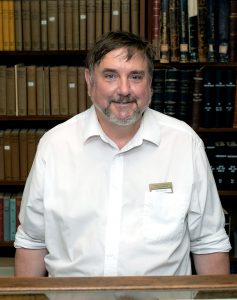The first Chautauqua Lake Sunday School Assembly was founded in 1874 primarily as a religious gathering, but science was always an integral part of it. The sacred and the scientific existed side by side from the beginning.
“Nothing is secular in any sense as to make it foreign or unattractive to the saints of God,” wrote Methodist Bishop John Heyl Vincent, who, along with industrialist Lewis Miller, founded the movement.
In the Assembly’s first season, two lectures were devoted specifically to science, according to Jon Schmitz, archivist and historian for Chautauqua Institution. And two years later, the assembly organized a “scientific congress” to introduce and explain discoveries of the era.
At 3:30 p.m. Friday in the Hall of Christ, Schmitz will examine the relationship between those two pillars of the Chautauqua experience in “Science and Religion (and Art) at Chautauqua,” as part of the Oliver Archives Heritage Lecture Series.
In one 1876 demonstration, Schmitz said, the head of a bull was brought in to display the effects of electricity on animal tissue.
“The head was hooked up to a battery, its eyes opened and stared at the audience,” he said. “Further electric shocks caused the animal’s mouth to open and its tongue to move.”
In 1878, the Chautauqua Literary and Scientific Circle was created. In a letter to Vincent, the poet and journalist William Cullen Bryant had extolled the benefits of scientific education as essential to the development of the Christian citizen, Schmitz said, and it became a key element of the Chautauqua movement and the correspondence course offered by the CLSC.
“For the most part, science at Chautauqua was either presented as intellectual entertainment, or used to support the Assembly’s agreed-upon social and political agenda,” Schmitz said.
Teaching science also focused on the practical and social. Interest in life sciences and conservation at the end of the 19th century led to the formation of the Bird and Tree Club (now the Bird, Tree & Garden Club), and practical summer courses in chemistry and natural history were popular, Schmitz said.

But, for the most part, the big scientific questions of the day, such as evolution, went unexamined.
Not until 1905 was there a lecture at the Institution devoted to Darwinism. And it was not until the Scopes Trial in the summer of 1925 that the subject caught fire at Chautauqua.
The Scopes Trial, referred to at the time as “the Scopes Monkey Trial,” pitted the state of Tennessee against a substitute high school teacher named John Scopes who brought up the subject of evolution in his classroom, a violation of state law. William Jennings Bryan, the three-time presidential candidate and a star of the Chautauqua speaking circuit, assisted the prosecution, and Clarence Darrow, the country’s preeminent trial lawyer, called the then-director of Chautauqua’s Department of Religion, Shailer Mathews, as a witness for the defense. It was, in many ways, the trial of the century. The Bible vs. Science.
That summer, Samuel Christian Schmucker, an authority on evolution, spoke daily for an entire week at the Amphitheater.
“Interest in the subject of man’s evolution has never been shown here so strongly as during this series of lectures,” The Chautauquan Daily reported at the time. “About 4,000 people listened to Dr. Schmucker’s address with marked attention, and hardly an auditor left the Amphitheater until it was completed.”
Scopes was convicted. The schism between religion and science seemed deep and clear to many Americans.
“In the past, people had come to Chautauqua to have sense made of their world, in particular to have the moral meaning of events explained by having them retold in the vocabulary of the Bible,” Schmitz said. “It was not that Chautauquans had now lost faith in God, or the Bible, but they did lose faith in the world, and turned more to art to find meaning in a world that was confusing and frightening.”
Schmitz believes that was a positive development “because it introduced a broader sense of truth, a new approach to truth that allows a better accommodation of religion and science.”
From that point on, the Chautauqua experience began to focus as much on art and music as much as on religion and knowledge, he said. Henry Turner Bailey, the head of the Institution’s arts program, believed everyone should be educated in the arts.
“Not so that they would be artists and produce great works of art, but so they could learn how to recognize beauty in the world,” Schmitz said. “Ultimately, art illustrates a pragmatic approach to truth, which is compatible with the methodology of modern science and with religious faith. And experiencing reality with an understanding of its possibility provides an opportunity for art and science and religion to agree.”
That, Schmitz argues, is what the concept of the Sabbath is all about and, as Vincent often said, Chautauqua was all about the Sabbath. It is what Chautauqua is still all about.




